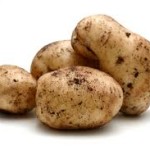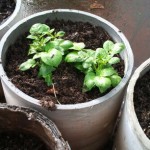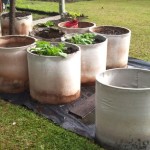Potato Experiment
I was at a grower’s co-operative store about a month ago and they had some seed potatoes for sale. They were at the ridiculously cheap price of $2.00 per kg. I became the big spender, let the moths out and bought a kilo. I think they are Sebagoes but am not really sure. They were a whitey/cream colour when I bought them.
When I got home I got enthusiastic and used a couple of my cardboard tubes to plant them in.
I wasn’t sure how many to put in so only put a potato each side of the container. I had some old chicken manure that had been sitting around aging for about 12 months. I added this to the tubes with some compost and worms. It took about 2 weeks for the shoots to appear and they have powered on since then, although it has been cold and very wet.
I knew that as they grew I would get a better harvest if I kept adding compost to the tube making the leaves grow up further and giving more room for the tubers to grow.
It has also had a benefit of keeping the bed from sitting in water. The tubes are about 75cm (2.5 ft) high.
I put the rest of the seed potatoes in the shed and forgot about them until the other day. Acting on my new resolution to do it now, I put some compost and worm castings in a third cardboard tube and placed the remaining 8 seed potatoes in.
You can see that the original plantings are growing well and I have nearly filled the containers with compost. Container 3 has a lot more seed potatoes in it and it will be interesting to find out which tube gets the best harvest.
Update 14 March 2015
As I write more posts and figure out ways to do things with my site, I find that there are many things I missed when starting out. So I have been going back and trying to make improvements.
This post was left hanging and there is no results section. Well here it is based on my memory of over 12 months ago.
The results weren’t as good as expected, the yield was quite poor. The best yielding container was the one with the 8 seed potatoes. The potatoes in all three containers were not very big. However they did taste great and it certainly makes a difference when you can dig up your potato and cook it the same day.
Since this experiment, I have grown potatoes in the ground and hilled them up as they grew. I also had a dripper system for watering. They had a much larger crop than the potato container experiment ones.





